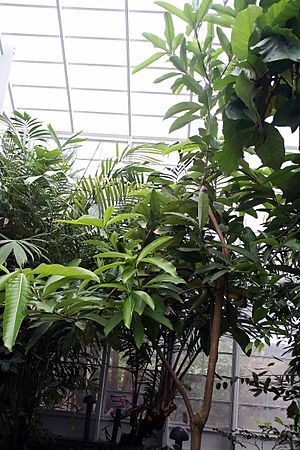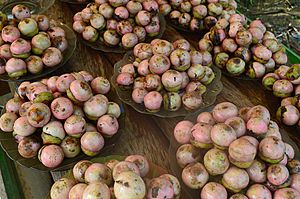Engkala facts for kids
Quick facts for kids Engkala |
|
|---|---|
 |
|
| Young Litsea garciae tree at the Fairchild Tropical Botanic Garden, Miami, Florida | |
| Conservation status | |
| Scientific classification | |
| Genus: |
Litsea
|
| Species: |
garciae
|
| Synonyms | |
The Litsea garciae is a fascinating flowering tree. It's known by many names, like engkala, kalangkala, and even the Borneo avocado. This tree belongs to the Lauraceae family, which also includes the bay laurel plant.
Where It Grows
The Litsea garciae tree is originally from parts of Asia. You can find it in Taiwan, the Philippines, Brunei, Malaysia, and Indonesia. This includes places like Peninsular Malaysia and islands such as Borneo, Sumatra, Java, and Sulawesi.
Many people believe it first grew in the Philippines. However, some plant experts think it might have started in Borneo. It grows naturally in evergreen forests. You can also find it in open areas that have been disturbed. It likes to grow near rivers and on hillsides. The tree prefers sandy or clay soils and partly shady spots. It can grow at elevations up to 200 meters (about 656 feet) high.
What It Looks Like
The Litsea garciae is a medium to large evergreen tree. It can grow quite tall, reaching 10 to 26 meters (about 32 to 85 feet). Its trunk can be as wide as 60 centimeters (about 23 inches).
The leaves are dark green and grow one after another along the branches. They are shaped like a spear or an egg. Each leaf is smooth and measures about 25-40 centimeters (10-16 inches) long. They are also 6-15 centimeters (2-6 inches) wide. The leaves hang down a little from the branches.
The tree has small, yellow-white flowers. The entire flower head is about 15 millimeters across.
The Fruit
The fruit of the Litsea garciae is round or slightly flattened. It is about 2.2-3 centimeters (0.8-1 inches) tall. It measures 2.5-4.5 centimeters (1-2 inches) across. This fruit is edible and tastes a bit like a milky avocado.
When the fruit is not ripe, its skin is a pale whitish-green. As it ripens, the skin turns pink to red. The inside of the fruit is soft and white, sometimes with a hint of green. It has a large green stem cap. Inside, there is one big, brown seed. This seed is about 1.5-2 centimeters (0.6-0.8 inches) wide.
The tree starts to produce fruit when it is about five years old. It does not like cold weather. It cannot handle frost or temperatures below 12 degrees Celsius (55 degrees Fahrenheit).
How People Use It
The fruit of the Litsea garciae is very popular. People eat it raw or cook it. Sometimes, people even grow the tree just for its tasty fruit.
When eating it raw, people often roll the fruit in their hands. They might also gently hit it with a spoon. This helps to release its special flavor. A common way to enjoy the fruit is to put it in hot water for five minutes. Then, they sprinkle it with salt. It is also sometimes served steamed with rice. Unripe fruits can be pickled.
Other Uses
The seeds of the fruit contain an oil. This oil is used to make candles and soap. The wood from the tree is also used in construction.
Litsea garciae has many traditional medicinal uses too.
- The Iban use the bark to treat stings from caterpillars. They also make a paste from the bark to help with boils.
- The Selako use a paste made from the leaves or young shoots. They mix it with shallots and fennel seeds. This mix helps to cure infections and skin diseases. It is also used for skin burns.
- The Penan use a bark paste for sprained knees, ankles, and muscle pains.
- Drinks made from the bark can help with certain stomach problems. The bark is also mixed with durian bark to create an antidote for snakebite wounds.
Healthy Benefits
The fruits of Litsea garciae are good for you. They contain natural compounds that act as antioxidants. Antioxidants help protect your body's cells. The fruit is also rich in certain healthy fats and has properties that can fight bacteria.



